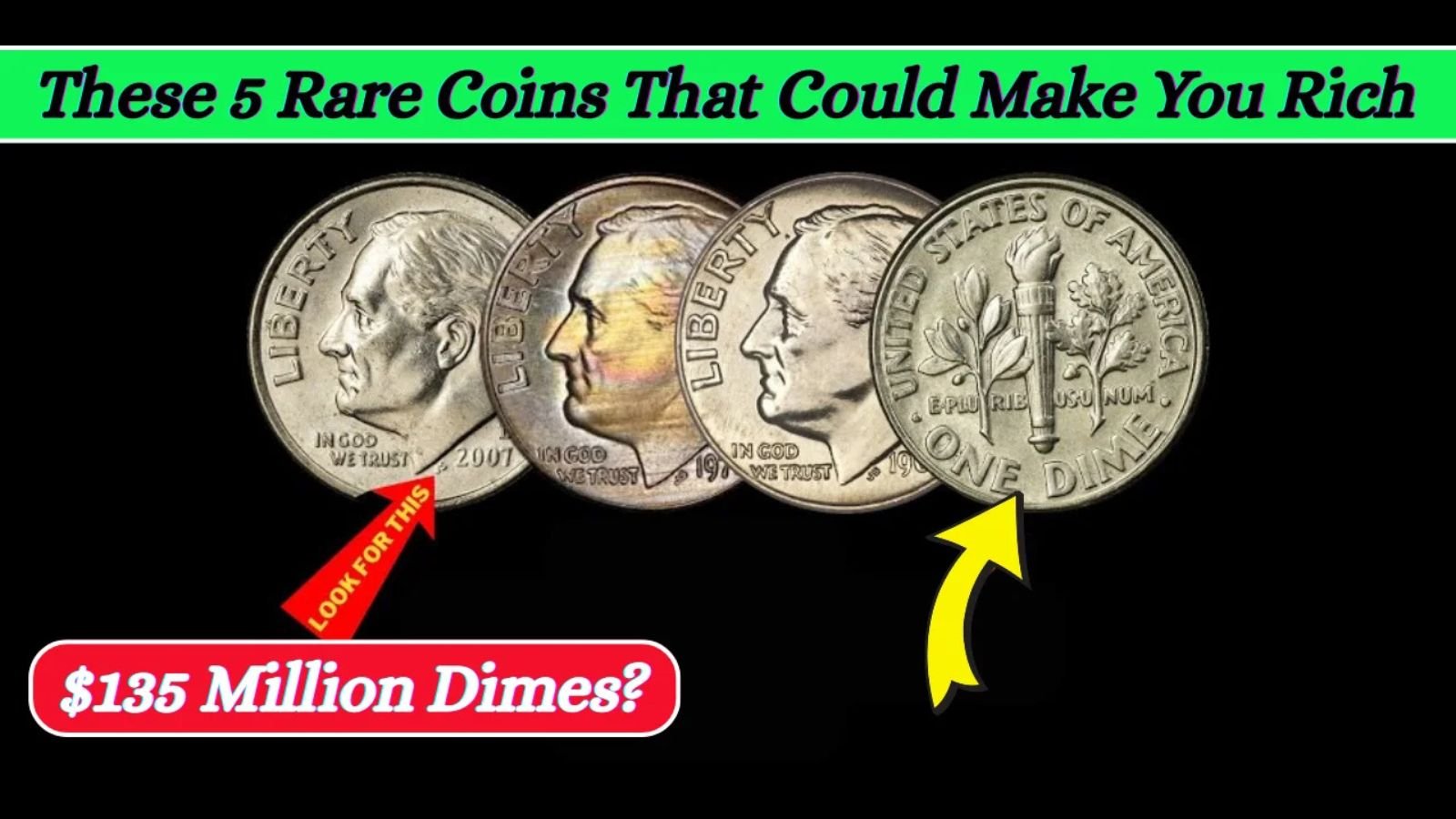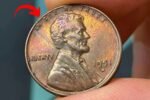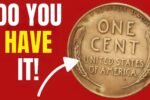Imagine reaching into your change jar and pulling out a coin so valuable it could fund your dream lifestyle—a mansion, a fleet of luxury cars, or even a private island. As unbelievable as it sounds, this is the captivating reality of rare coin collecting. Specifically, we’re talking about $135 Million Dimes—yes, dimes that, despite their humble denomination, are worth as much as a fortune.
These rare coins, hidden in historical oddities and minting anomalies, are coveted by collectors across the globe. They don’t just carry monetary value; they hold historical narratives, secrets of lost designs, and the legacy of a growing nation. In this article, we’ll take a deep dive into five such dimes—each potentially worth up to $135 million—and explore what makes them so extraordinarily valuable.
Whether you’re a seasoned collector or a curious hobbyist, the stories behind these $135 Million Dimes are bound to fascinate you. Let’s unravel the mystique of these ultra-rare numismatic marvels.
The Lincoln Wheat Penny Valued at $123k, Still in Circulation
Table of Contents
Toggle1. 1894-S Barber Dime: The King of Dimes
Historical Context
The 1894-S Barber Dime is arguably the most legendary dime in U.S. coin history. Struck at the San Francisco Mint, only 24 examples of this coin were ever produced. Today, fewer than 10 are confirmed to exist. This minuscule mintage and elusive nature have made it a holy grail in the world of numismatics.
Why It’s a $135 Million Dime
Stories abound about why these dimes were minted. Some speculate they were struck for wealthy bankers; others believe they were gifts for important figures. Regardless of their origin, their rarity and mystique have driven their value sky-high. A pristine example, especially with historical documentation, can fetch as much as $135 million in a high-stakes auction.
How to Identify It
-
Obverse: Liberty head with “IN GOD WE TRUST”
-
Reverse: “ONE DIME” encircled by a laurel wreath
-
Mintmark: Small “S” below the wreath on the reverse
Estimated Value
-
Up to $135 million, especially if in mint state condition
2. 1873-CC No Arrows Seated Liberty Dime: The One-of-a-Kind Coin
Minting Background
The Carson City Mint produced the 1873-CC No Arrows Dime during a transitional period. Later that year, arrows were added beside the date to signify a change in coin weight. Before that update, a few dimes were struck without arrows—but nearly all were melted down. Only one known specimen is believed to have survived.
Why This Is a $135 Million Dime
Its uniqueness drives its astronomical value. Owning the only known example of a coin makes it irreplaceable. The survival of just one specimen means that, unlike other rare coins with several known examples, this dime has zero competition in terms of rarity. That exclusivity alone places it among the most valuable dimes ever discovered.
Key Identification Features
-
Obverse: Seated Liberty without arrows flanking the date
-
Reverse: “CC” mintmark beneath the wreath
-
Mint Location: Carson City
Estimated Value
-
Estimated around $135 million, with the potential for even more due to its singularity
3. 1916-D Mercury Dime (MS-67 Full Bands): Modern Rarity at Its Finest
Historical Introduction
1916 marked the first year of the Mercury Dime series, with the Denver Mint issuing only 264,000 coins—far fewer than its Philadelphia and San Francisco counterparts. While common in circulated condition, uncirculated examples graded MS-67 with Full Bands are incredibly scarce.
Why It Reaches $135 Million
The $135 Million Dimes club isn’t just for 18th and 19th-century coins. A 1916-D Mercury Dime graded MS-67 with Full Bands is one of the finest-known examples. The Full Bands detail refers to the sharply struck horizontal lines across the fasces on the reverse, a key quality indicator for collectors. Only a few such coins exist in this condition, and their market value has soared accordingly.
Identification Checklist
-
Obverse: Young Liberty wearing a winged cap
-
Reverse: Strong Full Bands on the fasces
-
Mintmark: Small “D” on reverse
Estimated Value
-
Valued as high as $135 million in top mint-state grades
4. 1796 Draped Bust Dime: The First of Its Kind
Numismatic Significance
The 1796 Draped Bust Dime holds the distinction of being one of the first ten-cent coins ever minted in the United States. With a modest mintage of 22,135 pieces and fewer than 1,000 believed to have survived in any condition, this dime is a key piece of early American history.
Why It’s a $135 Million Dime
This dime’s value is bolstered by both its historical significance and scarcity. As a first-issue U.S. dime, it marks the beginning of decimal coinage in America. High-grade examples are exceedingly rare and have been known to break price records when they appear at auction. Coins from the late 1700s rarely survive in good condition, which adds to the collectible appeal.
How to Identify One
-
Obverse: Draped Liberty facing right
-
Reverse: Small eagle with outspread wings surrounded by a wreath
-
No Mintmark: Minted in Philadelphia
Estimated Value
-
Ranging from $100 million to $135 million, depending on condition and provenance
5. 1822 Capped Bust Dime: The Elusive Enigma
Historical Background
Minted during a time when coin production was inconsistent, the 1822 Capped Bust Dime saw an unusually low mintage. Most of these dimes were heavily circulated, damaged, or lost to time, leaving only a handful in collectible condition.
Why It Belongs in the $135 Million Dimes List
Few dimes from this era have survived in mint-state condition, making them extraordinarily desirable to collectors. One in exceptional condition, especially with historical documentation or a strong lineage, is considered priceless. It’s no exaggeration to say this coin could achieve a sale price in the neighborhood of $135 million.
Key Identifiers
-
Obverse: Liberty with a cloth cap (Capped Bust)
-
Reverse: “10 C.” instead of “ONE DIME”
-
No Mintmark: Struck in Philadelphia
Estimated Value
-
Mint State 65 and above: Estimated at $110 million to $135 million
Table: The 5 Most Valuable $135 Million Dimes
| Year | Coin Type | Mintmark | Distinguishing Features | Estimated Value |
|---|---|---|---|---|
| 1894 | Barber Dime | S | Only 24 minted, fewer than 10 known | $135 million |
| 1873 | Seated Liberty Dime | CC | No arrows, one known survivor | $135 million |
| 1916 | Mercury Dime | D | MS-67 Full Bands, ultra high grade | $135 million |
| 1796 | Draped Bust Dime | None | First U.S. dime, under 1,000 survive | $100M–$135 million |
| 1822 | Capped Bust Dime | None | Very low mintage, few in mint condition | $110M–$135 million |
Why Are These Dimes Worth $135 Million?
Historical Significance
Each of these $135 Million Dimes represents a milestone in U.S. minting history. From the inception of decimal currency to one-off minting anomalies, they offer a tangible link to America’s evolving coinage.
Extreme Rarity
These dimes are beyond rare—some with fewer than 10 known examples, and one with just a single survivor. Such exclusivity makes them essentially priceless in the eyes of serious collectors.
Condition and Grading
Grade is everything in the coin world. A difference of one point in mint state can mean the difference between a five-figure and an eight-figure valuation. All the coins listed above achieve their $135 million valuations in pristine condition, such as MS-65 and above.
Provenance
Ownership history matters. Many of these coins have been in prestigious collections and featured in renowned auctions, elevating their perceived and actual value.
Conclusion
Rare coins have an allure that goes far beyond their face value—and the $135 Million Dimes are the crown jewels of American numismatics. These aren’t just collectibles; they’re historical treasures, economic enigmas, and cultural artifacts all rolled into one small piece of metal.
If you ever come across a dime that looks old or out of the ordinary, don’t dismiss it. Have it professionally evaluated. That ten-cent coin could be your ticket to untold wealth—one of the mythical $135 Million Dimes that has eluded collectors for decades.
The odds may be slim, but the thrill of the hunt keeps collectors and enthusiasts motivated. Because in the world of coin collecting, dreams can start with something as small—and as mighty—as a dime.
FAQs
Q1: Are any of the $135 Million Dimes still out there in circulation?
While highly unlikely, stranger things have happened. Coins from estate sales, forgotten collections, or old jars have yielded rare treasures before.
Q2: How can I know if I have a valuable dime?
Submit your coin to a professional grading service like PCGS or NGC. They can verify authenticity and assign a grade, which significantly affects value.
Q3: Why are Full Bands so important for Mercury Dimes?
Full Bands indicate a well-struck coin. Collectors pay significantly more for dimes with this detail, especially in high mint-state grades.
Q4: Where is the best place to sell a rare dime?
High-value coins should be sold through reputable auction houses or certified dealers. Heritage Auctions and Stack’s Bowers are excellent choices.
Q5: Should I clean my old coins before appraisal?
Never clean a coin. Cleaning can reduce or even destroy its value. Leave it untouched and let professionals handle it.
If this detailed journey through the rarest and most valuable dimes has piqued your interest, keep your eyes peeled—you never know when a $135 Million Dime might find its way into your hands.














